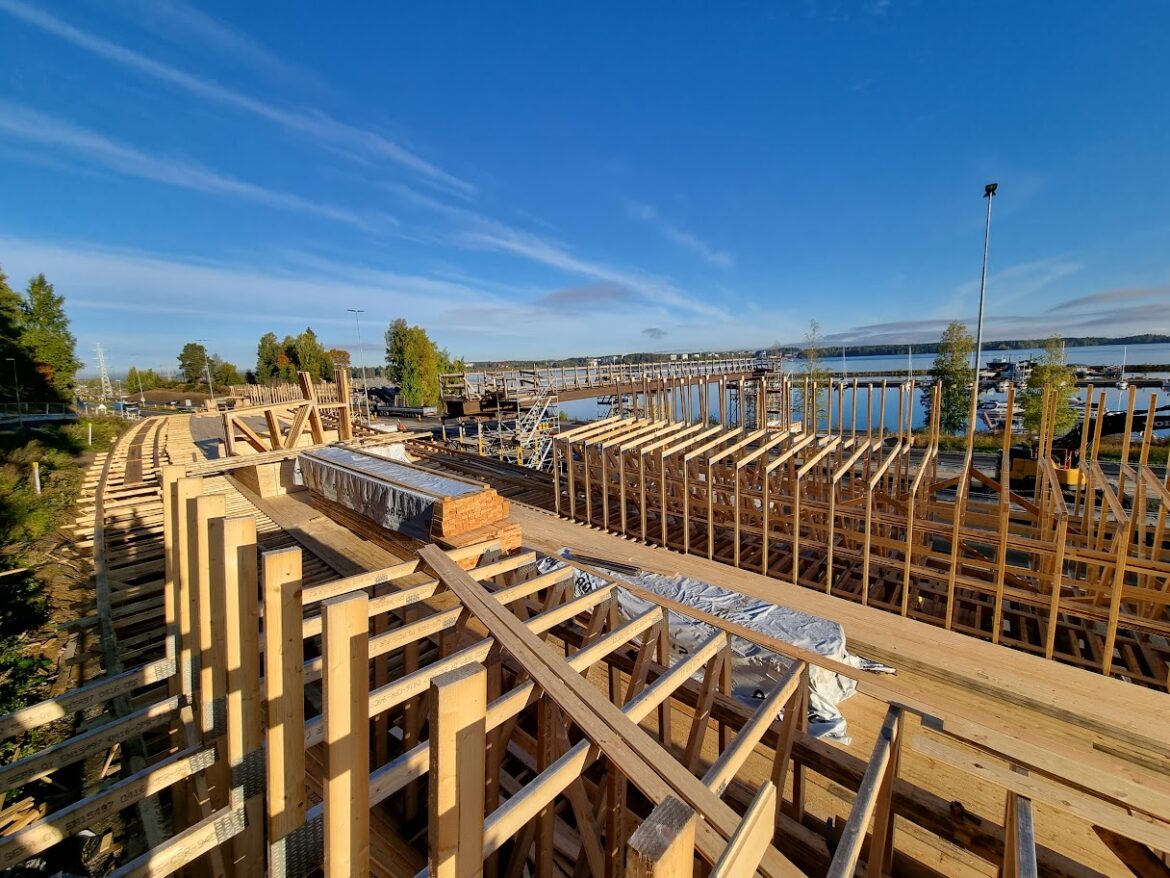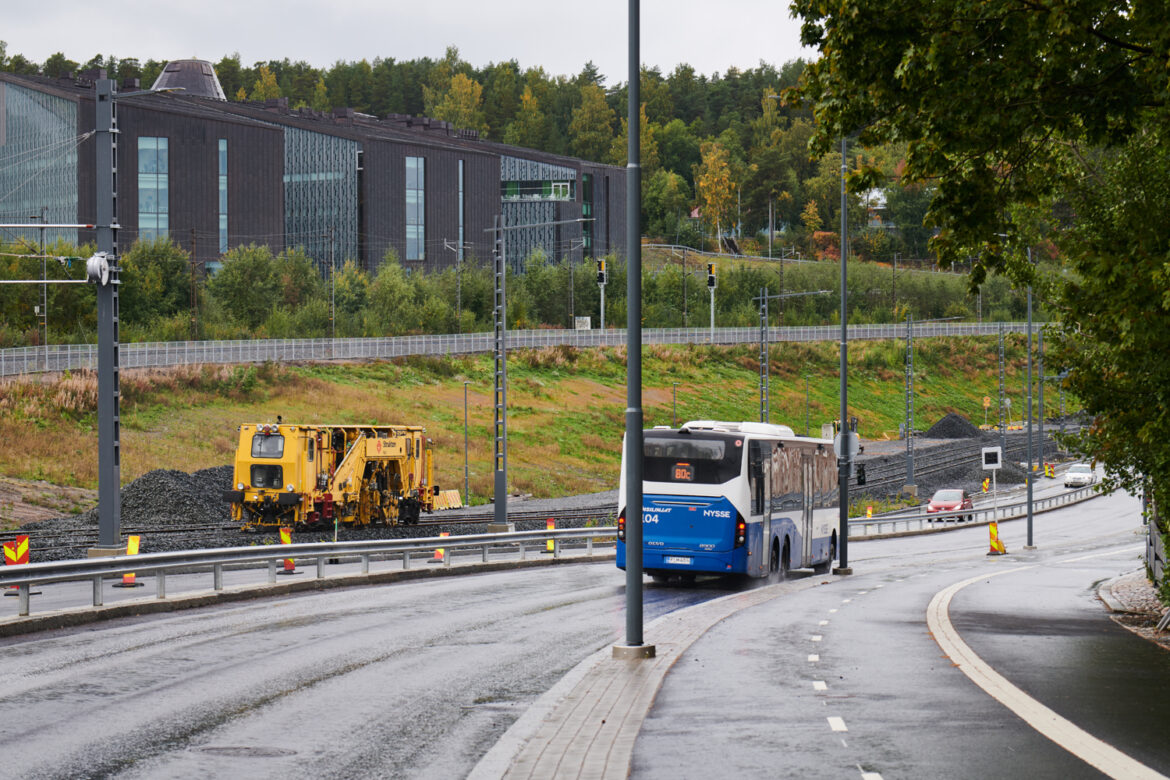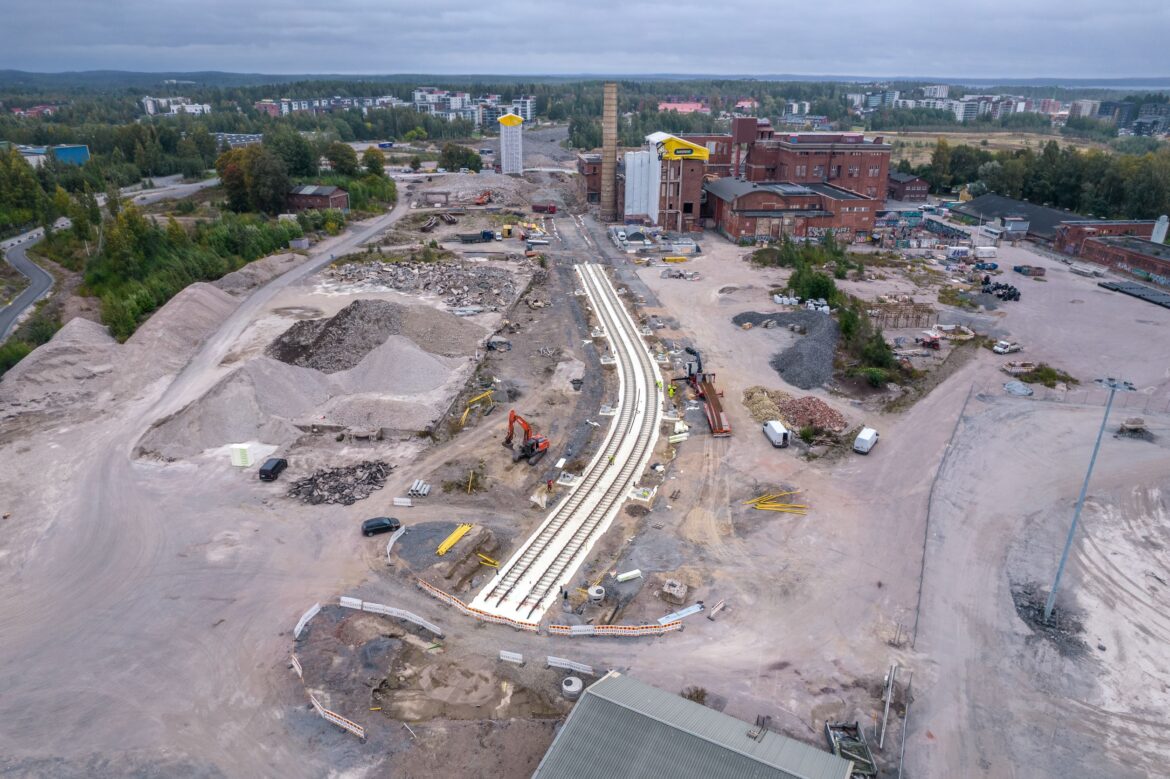Approximately half of the tracks will be completed in the western section of the tramway this year – construction is proceeding as planned
The construction of the western section of the Tampere tramway, i.e. the Pyynikintori–Santalahti–Lentävänniemi section, will continue on schedule. During the summer, the track work has progressed even faster than anticipated, and at the end of the autumn, more than three kilometres of the rail installations in the western section will be completed. A total of 6.6 kilometres of double tracks will be installed on the western section of the tramway.
– “During the summer, construction has progressed excellently throughout the whole Pyynikintori–Lentävänniemi section. The Santalahti area is now undergoing overhead contact line installations, once all the track work between Pyynikintori and Santalahti has been completed. The first tramway rails have already been installed in Hiedanranta, and the works planned for this year in the Niemenranta and Lentävänniemi areas will be completed on schedule,” says Sari Valjus, Project Manager of the Tramway Alliance.
Work between Sepänkatu and Santalahti aims to ensure that tram traffic to Santalahti can start next year, i.e. on 7 August 2023. It will be preceded by test drives between Pyynikintori and Santalahti next summer.
- “During the rest of the autumn and winter, overhead contact line installations will continue in Santalahti and the pedestrian and cycle routes and the rest of the street construction will be completed. Technical systems will also be installed in the tramway area and at the Paasikivenkatu electricity supply station,” says Valjus.
From Santalahti towards Lentävänniemi, the work of the Tramway Alliance will continue in the area of the western end of Rantatie and the Paasikiventie area, where a new Rosenlew tramway bridge will be built. In addition, the Paasikiventie street will be moved and also widened to the west to three lanes. The City of Tampere will continue to fill Näsisaari, which is due to be completed by the end of 2022.
- “Work in Näsisaari has progressed well and it is likely that the Tramway Alliance’s work in Näsisaari could start next summer with the construction of bridges to the island. However, the schedule is affected by the slump retention of Näsisaari filling. If the works on the island can be started as planned, it will be possible to start tram traffic to Lentävänniemi at the beginning of 2025,” Sari Valjus estimates.
In section 2, 44% of the time scheduled for the project has been spent and 41% of the work in section 2 is complete. The progress of tramway construction work will be reported on the Tramway Alliance website and in social media channels.
Approximately three kilometers of track laid
This year, the Tramway Alliance has built a double track of the tramway in all construction sectors, i.e. Santalahti, Hiedanranta and Lentävänniemi. On the Pyynikintori-Santalahti section, the track installations are ready. The length of the section from Pyynikintori to the western end of the Rantatie street is about two kilometres. During the autumn, the grassed tracks on Rantatie have been covered with soil and planted with seeds. At Paasikivenkatu, the ballast tracks were mechanically supported to their proper position in September. Welding work and finishing work on the ballast track will be still carried out in October, after which the ballast track section will be completed.
- “Track work is so ahead of schedule that the first rails were already installed in Hiedanranta in September. We initially estimated that the Hiedanranta track works would not start until next year, but we will already be able to install about 200 metres of double track in the area this year. In total, there will be 1.4 kilometres of tramway in Hiedanranta,” says Timo Kuusela, Superstructure Manager of the Tramway Alliance.
The installation of the double track will be completed on Federleynkatu and Kehyskatu, and approximately half of Lielahdenkatu will also be completed this year.
- “The rest of the superstructure of Lielahdenkatu as well as Halkoniemenkatu and Pyhällönpuisto’s final stop are scheduled for next year,” says Kuusela.
The western section of the Tampere tramway will also have a ballast track and a slab track with grass, stone or asphalt as a coating.
- “Approximately two kilometres of slab track will be installed this year and less than a kilometre of ballast track was installed on Paasikivenkatu. A total of 6.6 kilometres of double track will be installed in the whole western section, i.e. from Pyynikintori to Lenntävänniemi, of which 1.6 kilometres will be grass track, 2.4 kilometres will be ballast track and 2.6 kilometres will be asphalt or stone-covered slab track,” says Kuusela.
The Näsisaari section will be ballast track, the construction of which is estimated to start in summer 2024.
The tramway is completed once all technical systems have been installed. Technical systems include electrical track structures such as poles, overhead contact line support structures and overhead contact lines themselves. In addition, rail switch turning devices, traffic lights for the tramway, streetlights and data connections for the use of both the tramway and the city are installed.
Bridge work continues on the Rosenlew tramway bridge – construction of the Ollinoja bridge begins at Hiedanranta’s Sellupuisto
In the western part of Santalahti, the construction of the Rosenlew underpass over Paasikiventie has continued as planned in the summer. In the next few weeks, the scaffolding and cast mould for the tramway bridge deck will be built in the Rantatie area and the deck reinforcement work will begin. During October, openings in the bridge scaffolding will be built for Paasikiventie traffic and, in November, the foundations of the through span will be piled. The bridge deck scaffolding and mould work will be completed in the autumn, and the concrete casting of the deck will be carried out, depending on the weather, either towards the end of the year or next spring. The Rosenlew bridge will be more than 230 metres long and dedicated to tram traffic. The bridge crosses Paasikiventie from the western end of Rantatie and reaches the Pölkkylänpuisto, from where the tramway route will continue towards Hiedanranta via Näsisaari. The bridge is supported by five pillars in addition to abutments. The construction of the bridge can be followed from the live camera on the Tramway Alliance website.
In Hiedanranta, the construction of the Ollinoja bridge will begin in Sellupuisto in November. The new underpass connects the east and west sides of Sellupuisto, so that, in addition to the tramway, a separate pedestrian and cycling route runs across the bridge. Under the bridge, there will be a gravel-covered park walkway for pedestrians and cyclists. At this stage, a riverbed for Ollinoja, a small animal trail and a nature trail will also be built under the bridge. The Tramway Alliance will build the bridge area in connection with the tramway, and the rest of the Sellupuisto part will be renovated later by the City of Tampere.

The tramway work between Sepänkatu and Santalahti is almost completed
The tramway construction of the section between Pyynikintori and Santalahti began in November 2020 and is now in its final stages. The tramway test drives in the area will be carried out next summer. During the autumn and the coming winter, overhead contact lines and technical systems will still be installed on Sepänkatu, Paasikivenkatu and Rantatie.
Work by streets:
On Pirkankatu, the last asphalting works will be carried out at the beginning of October.
On Sepänkatu, the works are in the final stages. Railings are being installed on the street, and the new pedestrian and cycle route will be built on the east side of the street, which is scheduled to open to the public during November. In other respects, Sepänkatu has been opened for traffic. The traffic lights on Sepänkatu are also ready for tram traffic. Testing and adjustment of the traffic lights for trams will be carried out during test drives in summer 2023. For the time being, there is a combined pedestrian and cycle route on the western side of the street. Construction of the Sepänkatu bridge is completed.
On Paasikivenkatu, the roadway has been renewed in accordance with the street plan of the tramway. A new pedestrian and cycle route is being built on the south side of Paasikivenkatu, which extends from Tipotie to Sepänkatu. The new route is expected to be commissioned next spring when the overhead contact line installations and the installation and wiring of the electricity supply station at the Haarla curve have been completed. The hardware installations of Paasikivenkatu’s electricity supply station will begin in October. During the autumn, a lot of trees, shrubs and lawn areas have been planted and kerbstones installed in the Paasikivenkatu area. In October, the lane from Paasikiventie to Paasikivenkatu will be closed for a few nights due to railing installations. Then, a detour for car and bus traffic coming from the west will run via Rantatie.
On Rantatie, the edges of the slab track have been filled, grass tracks covered with soil, kerbstones installed and concrete and cobblestone paving work around the supporting wall carried out. There are four rail switches on Rantatie, whose last turning devices will be installed during October. Filling and paving work has been carried out at the tram stops at Santalahti and Tikkutehdas. On the Paasikiventie side, the final bus stop was commissioned in late September. The stop is accessed from Rantatie via the Tikkutehdas tram stop. The canopies for the bus stop and tram stops will be installed later next year. Car and bike traffic on Rantatie runs at its final place on the road.
Paasikiventie’s widening in the direction of the Log Floating Tunnel is progressing. At the beginning of October, asphalt paving will be carried out at Paasikiventie, followed by lane arrangements. The traffic arrangements are adopted to prepare for the situation when the Rantatie junction for those approaching from the west towards the city centre will be transferred about 250 metres at the beginning of October. The traffic arrangements and the transfer of the junction will be made due to the works of the Rosenlew overpass and the Paasikiventie renovation works. The pedestrian and cycle routes in the area will not change in connection with the transfer of the junction. The temporary pedestrian and cycle route built on the Pispalanrinne, which circles around the tramway site from the south of Paasikiventie, is in use. On Rantatie, cyclist must use the road. The technical bridge over Paasikiventie, which was used at the site in connection with the traffic arrangements, will be demolished. The bridge demolition work will be carried out as night work during week 40, and there will be temporary lane arrangements during the work.
In connection with the tramway works, the westbound Paasikiventie is moved and extended to three lanes up to the west side of the Tampere Log Floating Tunnel, where it will be combined with the earlier widening. In the Paasikiventie area, road railings are also being installed and a sewage line is being built in the central area. The widening of Paasikivientie is planned to be completed in autumn 2023.

Track foundation and municipal engineering for the new residential areas in Hiedanranta are being constructed
In Hiedanranta, tramway work began at the end of April and the tramway foundation and new municipal engineering were built in the summer. The first rails to Hiedanranta were installed between the factory area and the future Nottbeckinaukio in September. Long-term traffic arrangements have been made for cars, pedestrians and cyclists on Hiedanranta’s Tehdaskartanonkatu. During the summer, the loading berm built in Sellupuisto last year has been extended southwards, and the extension will compress the ground for about one year. The extra blasted rock of the original loading berm will be transported from Sellupuisto to Näsisaari to be used as landfill in October. The blasted rock transport will take about a month and it is carried out by the Näsisaari filling contractor. During the rest of the year, the construction of the tramway electricity supply station will also begin in Hiedanranta.

Half of the rail installations are ready in Niemenranta and Lentävänniemi
Municipal engineering replacement and track foundation works have continued on all tramway streets in Niemenranta and Lentävänniemi, meaning Federleynkatu, Kehyskatu, Lielahdenkatu and Halkoniemenkatu during the summer. The first rails to Niemenranta and Lentävänniemi tramway were installed on Federleynkatu at the end of May. During the summer, track works have progressed as planned and, at the same time, the street structures have been renovated in accordance with the street plan of the tramway.
Work by streets:
On Federleynkatu, the work on slab tracks, paving work and the street building will continue in different places during the rest of the autumn. In the track area, the surface structures of the track are being built, i.e. paving and asphalting. Filling and kerbstone installations are carried out on the edge of the track area. In addition to street construction work, new light poles and electrical poles will be installed on Federleynkatu in late October. A load-bearing growing medium has been built for the new street trees. Due to the works, Federleynkatu is currently a one-way street between Kehyskatu and Matilda Niemi. One-way maintenance traffic and property plot traffic are allowed in the area. The cycle path and the recommended pedestrian route are located mainly on the north side of Federleynkatu. On the section between Matilda Niemi and Sellupuisto, Federleynkatu is completely closed to car traffic.
On Kehyskatu, the rail installations began at the roundabout on Lielahdenkatu, which was converted into a T-junction during the works, in June. During the summer, the track foundation was built and rails were installed along the entire Kehyskatu, and the last track foundations and rail installations will be completed during the autumn. In addition, street construction work and construction of the load-bearing growing medium for new trees have been carried out as well as work on protective casings for pipes. In October, the work area will be partly moved to the eastern side of the street. The pedestrian and cycling route between Federleynkatu and Kehyskatu will also be returned to the western side during the autumn, if the S-market building construction allows it. The area of the roundabout is undergoing stonework and asphalt paving works. When they are completed, the T-junction will be closed and the roundabout will be back in use in around November. At the junction of Kehyskatu and Lielahdenkatu, the tramway electricity supply station’s building construction will continue during the autumn and winter.
On Lielahdenkatu, the track foundations were built and rails were installed on the section between the Kehyskatu junction and Lentävänniemenkatu during the summer. The last slab track castings will be made in October, and approximately half of the Lielahdenkatu track installations will be completed this year. During the summer, new structural layers have also been built for the carriageways and pedestrian and cycling routes. In October, once the street structures on the northern side of Lielahdenkatu have been completed, the work area will change. Traffic will be moved to the northern side of the street and street construction will begin on the southern side of the street. In Lielahdenkatu, two-way car traffic is maintained during the work, but lanes and centrelines are changed as the work progresses. During the construction, the pedestrian and cycling route will mostly be located north of Lielahdenkatu, but temporary changes are expected as the work progresses. Parking along Lielahdenkatu is forbidden due to work and parking spaces will be permanently removed. According to the street plan, there will no longer be street parking on Lielahdenkatu in the tramway area.
On Halkoniemenkatu, kerbstones have been laid and asphalt paving works have been carried out, and the construction of cable routes and track foundation are currently underway. Traffic in the direction of Pyhällönpuisto has been moved to the eastern edge of the street for the time being. The pedestrian and cycle route runs along the western side of Kehyskatu. Fences will be installed on top of the rock cutting in Halkoniemenkatu and Pyhällönpuisto during the autumn.
In Pyhällönpuisto, a loading berm that improves the load-bearing capacity of the ground has compacted the soil, where necessary, and transport of the blasted rock from the area will begin during the autumn. During the rock transport, traffic arrangements are made in Pyhällönpuisto and the routes are temporarily changed.
During the tramway works, traffic arrangements are in place on the streets, but access to the properties and maintenance runs are ensured at all stages. Night work is also carried out as necessary for safety reasons and in order to minimise disruption to traffic.
The Tramway Alliance will provide information about the construction of the western part of the tramway and its impact on the Tramway Alliance website and social media channels.
The City of Tampere is responsible for the construction of Näsisaari and providing related information.
Further information on tram and bus traffic and the special routes during construction is provided by Tampere regional transport, Nysse.
More information about the Tampere Tram is provided by Tampereen Ratikka.